Related Research Articles

Year 1324 (MCCCXXIV) was a leap year starting on Sunday of the Julian calendar.

Philip VI, called the Fortunate, the Catholic and of Valois, was the first king of France from the House of Valois, reigning from 1328 until his death in 1350. Philip's reign was dominated by the consequences of a succession dispute. When King Charles IV of France died in 1328, his nearest male relative was his sororal nephew, Edward III of England, but the French nobility preferred Charles's paternal cousin, Philip of Valois.

Charles IV, called the Fair in France and the Bald in Navarre, was last king of the direct line of the House of Capet, King of France and King of Navarre from 1322 to 1328. Charles was the third son of Philip IV; like his father, he was known as "the fair" or "the handsome".

Aymer de Valence, 2nd Earl of Pembroke was an Anglo-French nobleman. Though primarily active in England, he also had strong connections with the French royal house. One of the wealthiest and most powerful men of his age, he was a central player in the conflicts between Edward II of England and his nobility, particularly Thomas, 2nd Earl of Lancaster. Pembroke was one of the Lords Ordainers appointed to restrict the power of Edward II and his favourite Piers Gaveston. His position changed with the great insult he suffered when Gaveston, as a prisoner in his custody whom he had sworn to protect, was removed and beheaded at the instigation of Lancaster. This led Pembroke into close and lifelong cooperation with the king. Later in life, however, political circumstances combined with financial difficulties would cause him problems, driving him away from the centre of power.
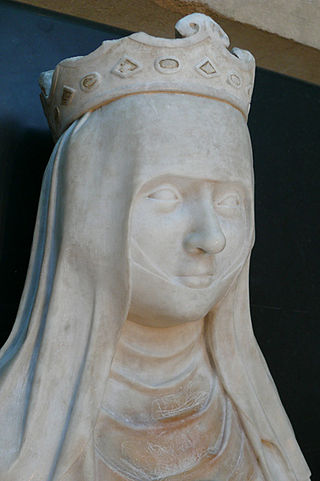
Joan of Évreux was Queen of France and Navarre as the third wife of King Charles IV of France.

Edmund of Woodstock, 1st Earl of Kent, whose seat was Arundel Castle in Sussex, was the sixth son of King Edward I of England, and the second by his second wife Margaret of France, and was a younger half-brother of King Edward II. Edward I had intended to make substantial grants of land to Edmund, but when the king died in 1307, Edward II refused to respect his father's intentions, mainly due to his favouritism towards Piers Gaveston. Edmund remained loyal to his brother, and in 1321 he was created Earl of Kent. He played an important part in Edward's administration as diplomat and military commander and in 1321–22 helped suppress a rebellion.
The War of Saint-Sardos was a short war fought between the Kingdom of England and the Kingdom of France in 1324 during which the French invaded the English Duchy of Aquitaine. The war was a clear defeat for the English and led indirectly to the overthrow of Edward II of England. It can also be seen as one of the precursors to the Hundred Years' War.

Marie de St Pol, Countess of Pembroke was the second wife of Franco-English nobleman Aymer de Valence, 2nd Earl of Pembroke, and is best known as the founder of Pembroke College, Cambridge.

John Hastings, 2nd Earl of Pembroke, was a fourteenth-century English nobleman and soldier. He also held the titles of Baron Abergavenny and Lord of Wexford. He was born in Sutton Valence, the son of Laurence Hastings, 1st Earl of Pembroke, and Agnes Mortimer, Countess of Pembroke. His father died when John Hastings was around one year old, and he became a ward of King Edward III while remaining in his mother's care. The King arranged for John to marry Edward's daughter Margaret in 1359, which drew John into the royal family. However, Margaret died two years later. John Hastings inherited his father's earldom, subsidiary titles and estates in 1368. The same year, he made a second marriage, to Anne, daughter of Walter, Lord Mauny. The following year, Pembroke began the career in royal service that continued for the rest of his life.
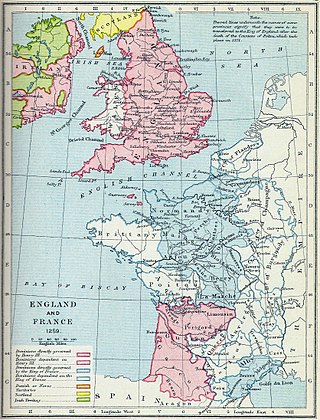
The 1303 Treaty of Paris was a peace treaty between King Edward I of England and Philip IV of France that ended the 1294–1303 Gascon War. It was signed at Paris on 20 May 1303, largely provided for a return to the status quo ante, and maintained peace between the two realms until the 1324 War of Saint-Sardos.
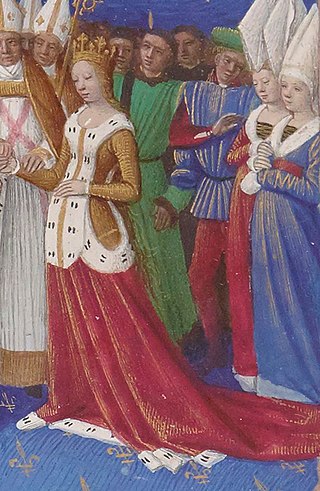
Marie of Luxembourg was Queen of France and Navarre as the second wife of King Charles IV and I.

The Diocese of Évreux is a Latin Church diocese of the Catholic Church in Rome. The diocese comprises the department of Eure within the Region of Normandy. The diocese is a suffragan of the Archdiocese of Rouen, and belongs to the ecclesiastical province of the same name.
Amanieu VII was the Lord of Albret from 1298 until his death; the son of Amanieu VI.
Bérard d’Albret, lord of Vayres and Vertheuil was a cadet member of the House of Albret in Gascony and an English commander during the Hundred Years War.
Marie of Brittany (1268–1339) was the daughter of John II, Duke of Brittany, and Beatrice of England. She is also known as Marie de Dreux.
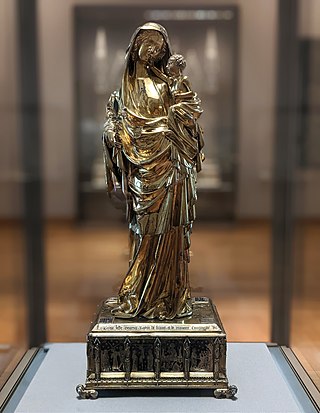
The Virgin of Jeanne d'Evreux, is a Gothic sculpture created sometime between the years 1324 and 1339. This figure stands at 68 cm tall and is made from gilded silver, stones, pearls, and the earliest dated French translucent enamels. The piece itself was donated to the abbey of Saint-Denis by Jeanne d'Evreux in 1339 as inscribed in the pedestal. Currently, this sculpture is on display within the Louvre in France.
Margaret was the eldest child of Philip of Artois and his wife, Blanche of Brittany. She was a member of the House of Artois. She was married to Louis d'Évreux. By her marriage, Margaret was Countess of Évreux.
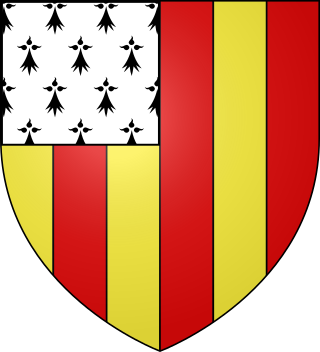
Ralph Basset, 2nd Baron Basset of Drayton was a 13th-14th century English nobleman who fought in both the Anglo-French War and in the First War of Scottish Independence.

Sir John Harpeden was an English knight and administrator who served Edward III of England in France during the Hundred Years' War. He served as seneschal of Saintonge (1371–72) and seneschal of Aquitaine (1385–89). His descendants became French lords. He is called John Harpeden I or John Harpeden the Elder to distinguish him from his son, Jean Harpedenne II.
The Treasury of Saint-Denis, kept at the Basilica of Saint-Denis in Paris until the French Revolution, was the main repository of the regalia of the Kingdom of France, including the ancien régime portion of what are now known as the French Crown Jewels. Its surviving items are presently scattered between the Louvre, the Cabinet des Médailles of the French National Library, and other museums.
References
- ↑ "Charles IV king of France". www.britannica.com. Retrieved 11 January 2025.
- ↑ Sumption, Jonathan (23 August 1999). Hundred Years War Vol 1: Trial by Battle. Vol. 1. Faber & Faber. pp. 159–161. ISBN 978-0571200955.
- ↑ RHGF XXI, E floribus chronicorum auctore Bernardo Guidonis, p. 733.
- 1 2 Christian Bouyer: Dictionnaire des Reines de France, Librairie Académique Perrin, 1992,
- ↑ Jonathan Sumption, The Hundred Years War, Volume 1: Trial by Battle (University of Pennsylvania Press, 1999) p.94-95
- ↑ Stephen Spinks, Robert the Bruce: Champion of a Nation (Amberley Publishing, 2019)
- ↑ David d'Avray, Papacy, Monarchy and Marriage 860–1600 (Cambridge University Press, 2015) p.232
- ↑ Philip Daileader, True Citizens: Violence, Memory, and Identity in the Medieval Community of Perpignan, 1162-1397 (BRILL, 2000) p.105
- ↑ "Edmund of Woodstock, Earl of Kent (1301–1330): a study of personal loyalty", by Penny Lawne, in Fourteenth Century England, ed. by Chris Given-Wilson (Boydell & Brewer, 2010) p.34
- ↑ Keane, Marguerite A. (2 June 2016). Material Culture and Queenship in 14th-century France: The Testament of Blanche of Navarre (1331-1398). Brill. p. 9. ISBN 978-9004248366.
- ↑ Benton, Janetta Rebold (August 27, 2009). Materials, Methods, and Masterpieces of Medieval Art. Praeger Publishing. p. 16. ISBN 978-0275994181.
- ↑ "Virgin and Child of Jeanne d'Evreux | Louvre Museum | Paris". www.louvre.fr. Retrieved 2017-01-24.
- ↑ Danielle Gaborit-Chopin, "Vierge à l'Enfant de Jeanne d'Évreux", dans Le Trésor de Saint-Denis, catalogue d'exposition du musée du Louvre, Paris, RMN, 1991, n° 51, p. 246-254, ISBN 2-7118-2350-4.